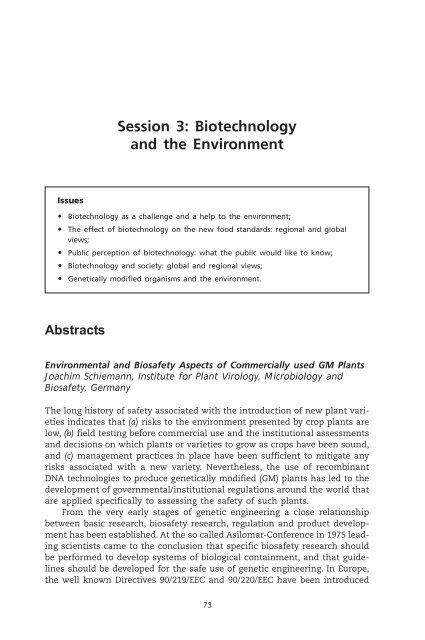TECHNOLOGY FORESIGHT SUMMIT - Unido
TECHNOLOGY FORESIGHT SUMMIT - Unido
TECHNOLOGY FORESIGHT SUMMIT - Unido
You also want an ePaper? Increase the reach of your titles
YUMPU automatically turns print PDFs into web optimized ePapers that Google loves.
Session 3: Biotechnology<br />
and the Environment<br />
Issues<br />
Biotechnology as a challenge and a help to the environment;<br />
The effect of biotechnology on the new food standards: regional and global<br />
views;<br />
Public perception of biotechnology: what the public would like to know;<br />
Biotechnology and society: global and regional views;<br />
Genetically modified organisms and the environment.<br />
Abstracts<br />
Environmental and Biosafety Aspects of Commercially used GM Plants<br />
Joachim Schiemann, Institute for Plant Virology, Microbiology and<br />
Biosafety, Germany<br />
The long history of safety associated with the introduction of new plant varieties<br />
indicates that (a) risks to the environment presented by crop plants are<br />
low, (b) field testing before commercial use and the institutional assessments<br />
and decisions on which plants or varieties to grow as crops have been sound,<br />
and (c) management practices in place have been sufficient to mitigate any<br />
risks associated with a new variety. Nevertheless, the use of recombinant<br />
DNA technologies to produce genetically modified (GM) plants has led to the<br />
development of governmental/institutional regulations around the world that<br />
are applied specifically to assessing the safety of such plants.<br />
From the very early stages of genetic engineering a close relationship<br />
between basic research, biosafety research, regulation and product development<br />
has been established. At the so called Asilomar-Conference in 1975 leading<br />
scientists came to the conclusion that specific biosafety research should<br />
be performed to develop systems of biological containment, and that guidelines<br />
should be developed for the safe use of genetic engineering. In Europe,<br />
the well known Directives 90/219/EEC and 90/220/EEC have been introduced<br />
73

















